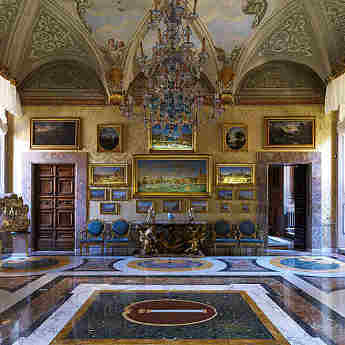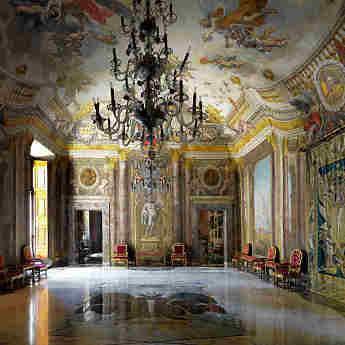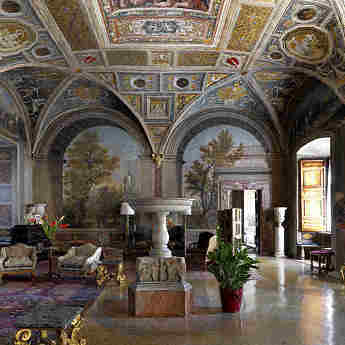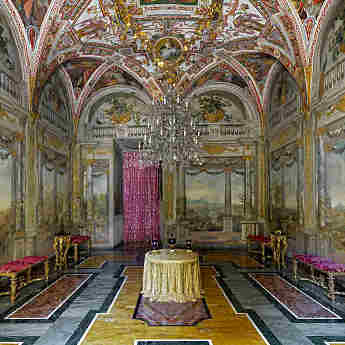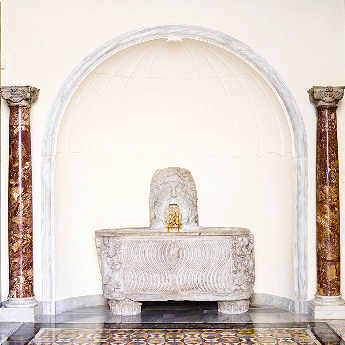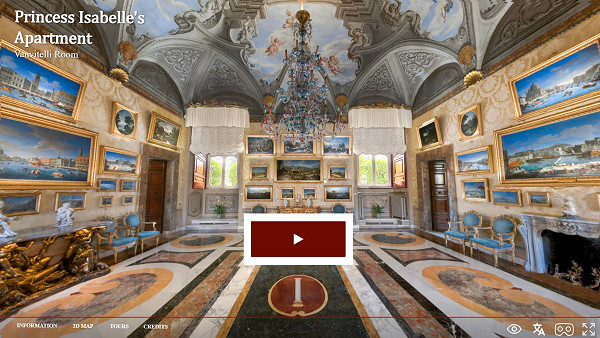Where Princess Isabelle received Queen Elizabeth
In one of the grandest palaces of the world, there is a gallery just as marvelous as the great halls of Versailles.
- Vanvitelli Room
- Ball Hall
- Hall of the Fountain
- Dughet Hall
- Mask Room
Here the Colonna Princess preserves the apartment formerly used by Princess Isabelle exactly as it was when she was still alive.
In the apartment you can find the same warm atmosphere, the same attention to detail and care to keep the family photos where they were originally placed, next to the famous collection of thirty-seven views of Vanvitelli.
This is not the only prized possession in this area, located on the ground floor of the palace which was built upon the foundations of the ancient Temple of Serapis.
One of the few traces of the Roman sanctuary is a crocodile in porphyry, which welcomes visitors at the beginning of the sequence of rooms where famous artists left their mark, such as Pinturicchio, Pomarancio and Cavalier Tempesta.
The floor of the apartment in “Venetian” style, is only partially ancient. The original floor is only visible in the hall of the fountain; in all the other rooms, the Princess replaced the traditional covering with shiny oriental marble, perhaps inspired by her Lebanese origins.
Isabelle Colonna, born Sursock, family of Byzantine origin, established in Lebanon since the 17th century, fell in love with Prince Marcantonio, who brought her to Italy, where she was able to integrate successfully into Roman society, at a time when it was up against the rise of Mussolini.
“Great lady-in-waiting, intelligent, educated, conservative in the most consistent and purest sense, after the fall of the monarchy she replaced Jose Maria as a “substitute queen”, offering regal receptions, where royalty and, among the bourgeoisie, only financiers and bankers were allowed, provided, of course, they were not divorced” (as Laura Laurenzi remembers it in the daily newspaper La Repubblica from 18 November 1984, on the occasion of her funeral).
In the last years of her life, her apartment turned into a treasure chest, which she loved to show only to her closest friends.
On the wall you can still see the canopy with the family symbol. At the center of the rooms is the gilded wood console where chained Turks remind us of the famous Battle of Lepanto in 1571, where Marcantonio Colonna stopped the threat of Muslim invasion.
One of the rarest pieces is the painted night clock, kept between two ancient chests in the Hall of the Fountain: a silent internal mechanism moves the numbers which are lit from behind by a candle.
A little further in the back, a strange double sofa, which experts call confidenza or “intimacy”, recalls the many meetings that must have gone on within these walls for more than six hundred years.
In these lounges the presence of two other famous women of the family still lingers: Maria Mancini, whose likeness is preserved in the portrait by Simon Vouet, painter at the court of Louis XIV of France, and Olimpia Pamphili, evoked by doves with an olive branch painted on the ceilings of the first rooms of the apartment.
The first, niece of the powerful Cardinal Mazzarino, wrote in her diary about the adventures of her unhappy relationship with Lorenzo Onofrio Colonna, from whom she fled. To get her back to Rome, he closed the doors of all the lounges in Europe.
A sad ending to a relationship which had begun auspiciously, as evidenced by the painted ceiling by Giacinto Gimignani, where he portrays the encounter between an ancient column and a pair of fish, the heraldic symbol of Mancini.
Yet for a while Lorenzo Onofrio and Mary must have been happy: Maratta and Dughet even portrayed them in the guise of Venus and Paris, a role they may have interpreted at the famous costume balls they loved to organize.
On the wall next to their double portrait “in costume”, Jan Brueghel the Elder left nine fantastic miniature landscapes, painted on copper to bring out the warmth of the reds and the crystal purity of the blues. Just another of the many treasures hidden in this mansion, which reveals how often you can easily live in contact with absolute masterpieces.
From the book by COSTANTINO D’ ORAZIO
“The keys to unlock the the 99 secret places of Rome”
Palombi Editore – 2010










